Coronavirus: Aussies tested as researchers race to develop vaccine as China virus spreads
As China’s deadly coronavirus continues to kill more than 20 people, four Australian patients are being tested in NSW hospitals. Queensland researchers are also racing to find a vaccine.
News
Don't miss out on the headlines from News. Followed categories will be added to My News.
- China travel warning upgraded over virus fears
- Aussie uni students targeted by Beijing’s ‘agents of influence’
As the death toll from China’s deadly coronavirus rises, four Australian patients are being tested in NSW hospitals.
“The situation is evolving as the number of reported cases has increased with over 800 confirmed cases and 26 deaths,” NSW Chief Health Officer Dr Kerry Chant said.
“In NSW we have four cases currently under investigation, we currently do not have any confirmed cases of known coronavirus.
“All four patients have undergone testing and we are awaiting the results. While we are waiting for the test results they are in isolation so therefore they do not pose any risk of transmission.”
Dr Chant said that the patients currently under evaluation have become known through a variety of ways, including the recommendations of GPs, ER rooms and some being self presented.
No details of the four patients will be released during the investigation but confirmed cases will be announced to the public.
“We do want to encourage everyone to come forward for testing,” Dr Chant said.
“Anyone that has returned from Wuhan city or is a contact with a confirmed case anywhere, we really want you to present to get assessed.”
When asked if NSW Health authorities will be keeping track of passengers who have flown in from Wuhan in the past 14 days Dr Chant said it will be up to the individuals to self present.
It takes about six hours to confirm whether a patient presenting with flu like symptoms has contracted the coronavirus.
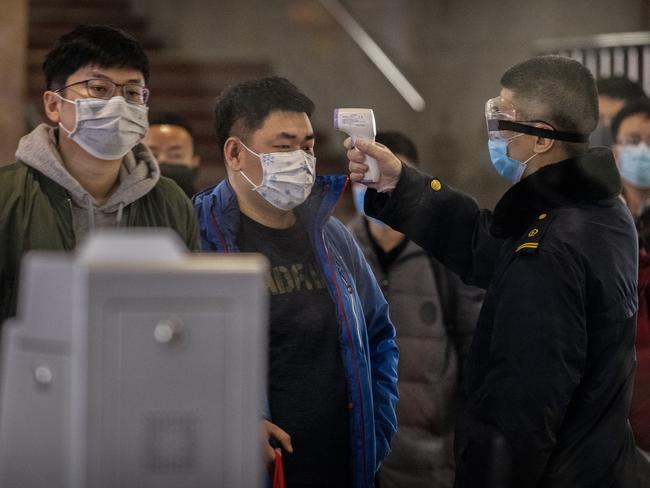
It comes as University of Queensland researchers are working round the clock to develop a vaccine for the deadly coronavirus in less than six months.
China’s National Health Commission revealed the number of cases of the new virus has risen to 830 with 25 deaths.
The update Friday morning also confirmed the first death outside the central province of Hubei.
The health commission in Hebei, a northern province bordering Beijing, said an 80-year-old man died after showing symptoms upon his return from a two-month stay in Wuhan to see relatives.
Wuhan is the capital of Hubei and has been the epicentre of the outbreak of the coronavirus first detected last month.
The Queensland researchers have been tasked with rushing a vaccine into existence, using rapid response technology that’s proven effective against other viruses in lab conditions.
The team hopes to have a safe and effective vaccine available for worldwide distribution within six months and they won’t even need the live virus to do it. Instead they will rely on new technology know as molecular clamp.
The team already has the genetic sequence of the coronavirus and will use that to produce a protein the same as what is on the surface of the virus. It’s that protein that engages the body’s immune defences.
“By injecting that we can get an optimal immune response in people that affords protection,” said Dr Keith Chappell, from UQ’s School of Chemistry and Molecular Biosciences and the Australian Institute for Bioengineering and Nanotechnology.
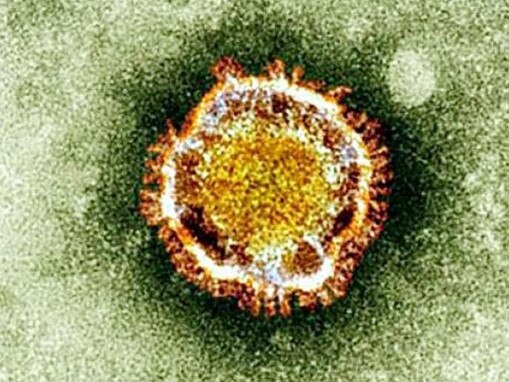
The Queensland researchers are among three teams around the world tapped by Coalition for Epidemic Preparedness Innovations to try to rapidly develop a coronavirus vaccine.
Dr Chappell says his team has a gruelling few months ahead, but they will do everything they can to have a safe vaccine available by the end of July or sooner if possible.
“That is our goal. It’s an incredibly difficult time frame, but we’ll do our best,” he told ABC radio.
“We’ve got a lot of testing ahead of us to make sure that it is both safe and effective before it can go into humans.”
He said there were no guarantees, but the vaccine development technology had proven effective against a number of other viruses in lab experiments.
“Unfortunately we’re seeing a situation that changes from day to day. Lives have been lost on a daily basis, which is why we’ve swung into action as quickly as possible.”

Meanwhile, Home Affairs Minister Peter Dutton defended Australia’s ability to guard against a potential pandemic of the deadly disease.
“We have the world’s best protocols in place,” Mr Dutton told the Nine Network.
“I think people should recognise that in a country like ours the health services are the best prepared, best able to respond, and they can quarantine people very quickly.”
The first plane load of passengers from Wuhan in China - the epicentre of the virus - touched down in Sydney on Thursday.
Passengers and crew wore face masks and those who flagged concerns about their health had their temperature taken.
NSW Health had doctors and nurses experienced in infection control at the airport working alongside the Australian Border Force. Virology experts were also there.
No ill passengers were found on the flight. However, those exposed to the virus may not display flu-like symptoms for up to a week.
CHINA VIRUS HAS EIGHT CITIES ON LOCKDOWN
Eight Chinese cities have gone into lockdown over the infectious coronavirus outbreak, in an attempt to curb the SARS-like virus from spreading.
It has also spread globally with cases confirmed in Japan (1), Thailand (4), South Korea (1), Taiwan (1) and the United States (1).

It came as four people were treated in the UK.
The patients are suffering flu-like symptoms and respiratory difficulties after arriving via London from Wuhan.
Three cases are in Edinburgh and the other is thought to be in Glasgow.
Tests have not ruled out the illness yet and the group are being treated at Glasgow’s Queen Elizabeth University Hospital.
The US has also raised its advisory warning for travel to China to a Level 3, which asks people to “reconsider” travel to the country.
The World Health Organisation said it is too early to declare the outbreak a global health emergency but it is an emergency in China.
CITIES QUARANTINED
Planes and trains going in and out of Wuhan, a city of 11 million people, were shut down by authorities on Thursday.
The South Morning China Post reports eight cities in the Hubei province – Wuhan, Huanggang, Ezhou, Chibi, Xiantao, Qianjiang, Zhijiang and Lichuan – are subject to travel bans, according to notices released by local governments.

Indoor entertainment venues, such as cinemas and internet cafes, have been ordered by authorities to close.
Citizens have also been told not to leave, unless under special circumstances.
Airports globally have stepped up the screening of passengers from China.
CORONAVIRUS OUTBREAK COULD BE WORSE THAN SARS
A leading virologist fears the coronavirus outbreak could be 10 times worse than the SARS epidemic that killed almost 800 people and sickened about 8000 between 2002 and 2003.
Dr Guan Yi, whose team was the first to track the SARS coronavirus back to its source, told Chinese news outlet Caixin that authorities had missed the “golden period” to prevent the spread of the new coronavirus.
“I have experienced so much and never felt scared. Most [viruses] are controllable, but this time I am scared,” Dr Guan said.
SARS first
Despite Chinese authorities putting Wuhan under lockdown, Dr Guan claimed the sources of infection had “spread out completely”.
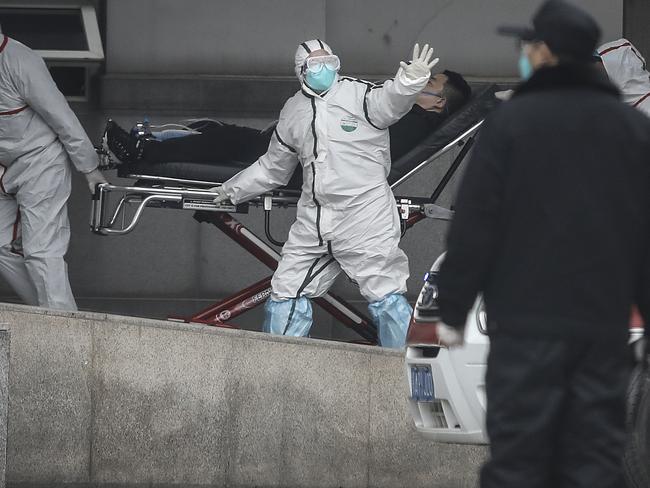
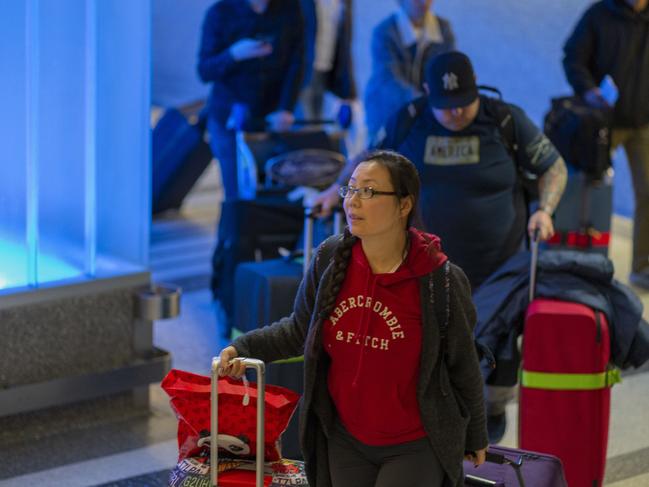
IS BAT SOUP RESPONSIBLE?
It has been claimed that the deadly virus may have spread to humans from bat soup.
Scientists in China yesterday claimed that the deadly strain shares a common ancestor with a virus found only in fruit bats.
“The Wuhan coronavirus’ natural host could be bats … but between bats and humans there may be an unknown intermediate,” researchers claimed.
Did patient zero really catch new Chinese virus by eating infected bat soup? It’s actually perfectly possible https://t.co/HzLJGb3xqB #InternationalTravelNews pic.twitter.com/Kl9KdcljHk
— Editor on eTN (@CNN_newstrend) January 23, 2020
Bat soup is reported to be an unusual but popular dish particularly in Wuhan, where the virus is understood to have originated at an open air fish market.
PASSENGERS ARRIVE IN SYDNEY FROM WUHAN
The lockdown follows the final flight allowed out of Wuhan arriving into Sydney.
The state’s chief health officer Kerry Chant confirmed all passengers were cleared on arrival by doctors. However, one person’s illness was investigated for coronavirus.
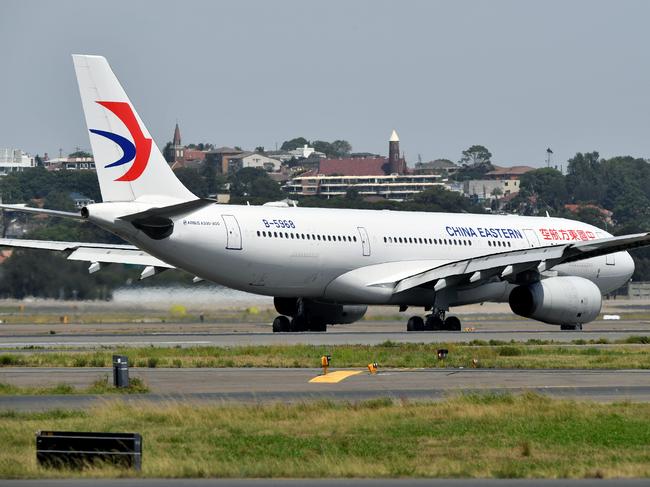
“We have one case that is currently under investigation. We are able to rapidly undertake testing of cases that come to our attention and either exclude or confirm those cases in a very short time frame,” Ms Chant said.
Passengers aboard before Wuhan went into lockdown described their flight to Australia as “scary” and “nerve-racking”.
Travellers on the 11-hour China Eastern Airlines flight from Xian via Wuhan, which landed in Sydney about 11am, were individually questioned by NSW Health officials while disembarking the plane.
Hornsby resident Kevin Ouyang, 40, said health officers boarded the aircraft to release a “disinfectant spray” immediately upon touchdown.

Mr Ouyang said he worried for his family and relatives back in China, and was advised to continue wearing his mask in public in the coming days.
“They told me to keep the mask on after I leave the airport for about 10 days during the incubation period,” he told The Daily Telegraph.
“Some government people got on the plane to spray everywhere.
“They asked me if I had a fever, a cough and about my trip history in Wuhan.
“There were almost 10 officers.
“They had equipment to scan for people’s temperature but I didn’t see anybody get taken away to hospital.”
MORE NEWS
‘Putrid’: Man charged after savage kangaroo attack
‘Love you Dad’: PM’s father passes away
PM under fire as McKenzie rejects resignation claims
Mr Ouyang, a father of two, said officials advised him to contact the hospital immediately if he started to feel unwell.
“If I start to feel sick, I have to call the hospital and tell them about my trip history,” he said.
“We were all very worried and very nervous on the flight, very worried about my family especially.”
Other passengers arriving at Sydney airport had similar feelings about the flight, some saying they “just wanted to go home” with others praising the efforts of NSW Health officers who acted “very professionally”.
Fu Gui, who was waiting for her sister and parents to arrive from Shenzhen, said it was concerning the plane from Wuhan was arriving into Sydney.

“I’m a little worried but I think the staff here will test them all,” she said.
The Australian government updated its travel advice on Thursday, urging all Australians to reconsider their need to travel to Wuhan.
A number of Australians have been tested for the virus with cases confirmed in Japan, Thailand and South Korea.
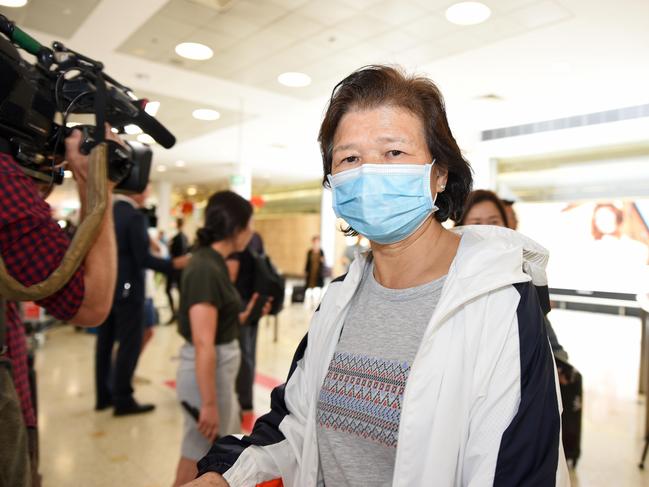
Australia’s Chief Medical Officer Brendan Murphy said the World Health Organisation had a meeting and have not yet declared it as a public health emergency of international concern. However, the team will meet again in the next 24 hours to reconsider the position.
“We are meeting again with all of the state and territory health officers this afternoon and tomorrow (Friday), to make sure we have good shared information,” he said.
“We are well-prepared and keeping a very close eye on this.”

The sprawling capital of central China’s Hubei province is the epicentre of the coronavirus, which is thought to have started in animals before spreading to humans.
Queensland Health on Wednesday confirmed a man who had been isolated after returning from visiting family in the Chinese city of Wuhan does not have the virus.
Prof Murphy said it was possible the virus would reach Australia but insisted the nation was equipped to respond.
Australia’s Foreign Affairs Department said anybody travelling to Wuhan should “exercise a high degree of caution” while in the city.

WHO director-general Tedros Adhanom Ghebreyesus described the coronavirus outbreak as “an evolving and complex situation”.
“Our team in China is working with local experts and officials to investigate the outbreak,” Mr Ghebreyesus said.
He was speaking after the WHO held a day-long meeting of an independent panel of experts in Geneva.
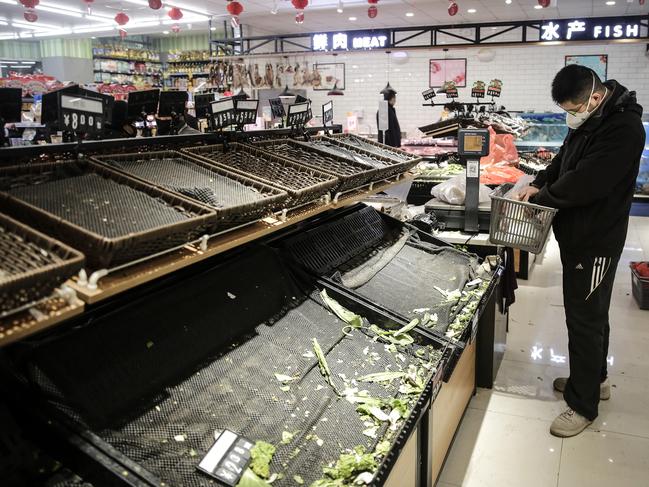
The WHO’s head of emergencies programme, Mike Ryan, said the priority now was to find the roots of how the virus is passing between people.
“We are in agreement with Chinese authorities who have been clear and transparent that there is evidence of human-to-human transmission,” he said.
“The primary issue is to limit (that) human-to-human transmission.”
LIFE ON THE GROUND IN WUHAN
The previously unknown coronavirus strain is believed to have emerged from an animal market in the central city of Wuhan, which health authorities are understood to have labelled “ground zero”.

Photos taken in the city of more than 11 million people paint a dire picture, with citizens donning face masks while also being subject to temperature screenings while going about their day-to-day life. Workers were also seen hosing down public spaces with disinfectant in a bid to stave off the virus.

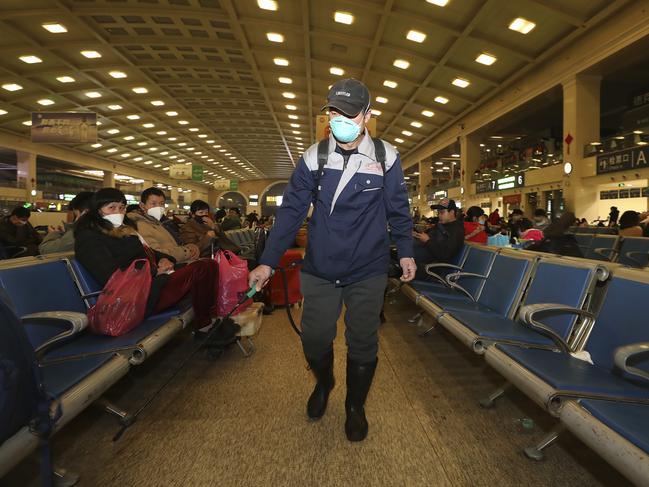

Everyone in the city of Wuhan was to be restricted to some degree. The state-owned People’s Daily newspaper said no one would be allowed to leave. The official Xinhua News Agency said no one would be permitted to leave without a specific reason.
Train stations and the airport were to shut down, while buses, subways, ferries and long-distance shuttle buses would also be temporarily closed.
The move is meant to “effectively cut off the virus spread, resolutely curb the outbreak and guarantee the people’s health and safety,” the notice said, according to the official Xinhua news agency.
Most of the cases are in Wuhan and surrounding Hubei province, but dozens of infections have popped up this week around the country as millions travel for the Lunar New Year, one of the world’s largest annual migrations of people.
The city’s tourism and culture department cancelled all group tours until February 8, Xinhua said.
Tourist attractions and star-rated hotels must also suspend all large-scale activities until that date, it added.
The provincial library and two major local theatres cancelled exhibitions and performances, while four museums have suspended operations until further notice, it said.



Pharmacies in the city limited sales of face masks to one package per customer as people lined up to buy them. Residents said they were not overly concerned as long as they took preventive measures.
“As an adult, I am not too worried about the disease,” Yang Bin, the father of a 7-year-old, said after buying a mask. “I think we are more worried about our kids.”
Medical workers in protective suits could be seen carrying supplies and stretchers into Wuhan Medical Treatment Center, where some of the patients are being treated.
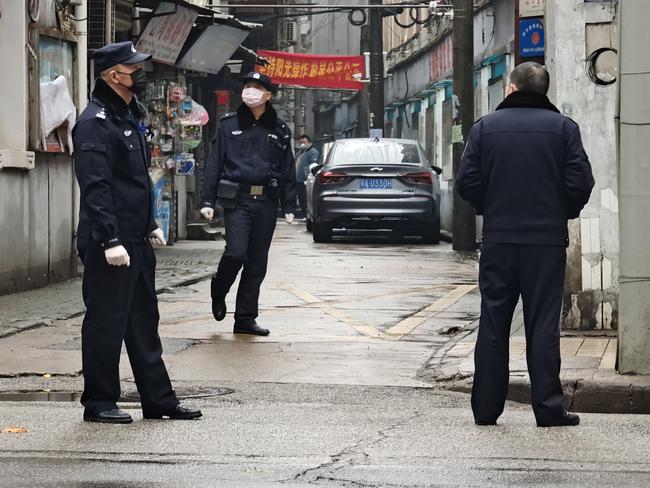
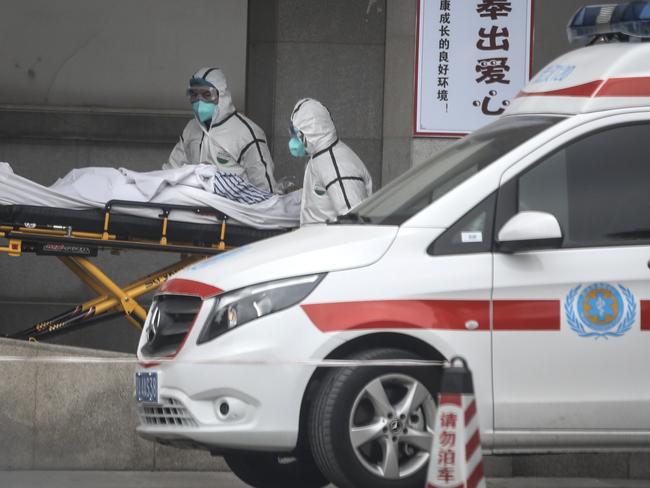
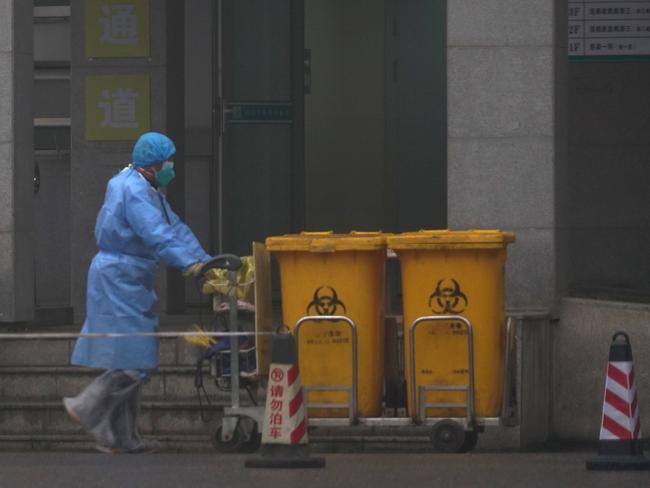
The hashtag “Wuhan is sealed off” was recently trending on China’s Twitter-like Weibo, with more than 30 million views.
“Once there’s a suggestion of a new development, the first thought is to maintain stability” and stop rumours, “hoping that by muffling it, it will go away,” one user said on Weibo.
Comments deemed politically sensitive are regularly censored on the social media platform.
Others commended the government’s response, with one person saying “we should spare no effort in supporting all of the country’s policy decisions”.
Fever scanners were checking passengers at the city’s airport and train station this week.
Footage on state broadcaster CCTV showed Wuhan medical staff in full-body protective suits, gloves and plastic face visors as they registered patients.
The patients, wearing normal clothes with face masks, had their temperatures checked as queues snaked out of the consultation room into the corridor.
DEADLY VIRUS ‘WILL REACH AUSTRALIA’
It is “quite likely” the virus will reach Australia, according to Australia’s Chief Medical Officer Professor Brendan Murphy.
Despite the risk, he said, the country was prepared to deal with the new and mysterious SARS-like novel coronavirus.
“We do have a lot of traffic from China and I think it’s quite likely we will get some cases here but I’m very confident that we’re well prepared to respond if we do,” Prof Murphy said.
A man was rushed to hospital from Melbourne Airport with respiratory issues.
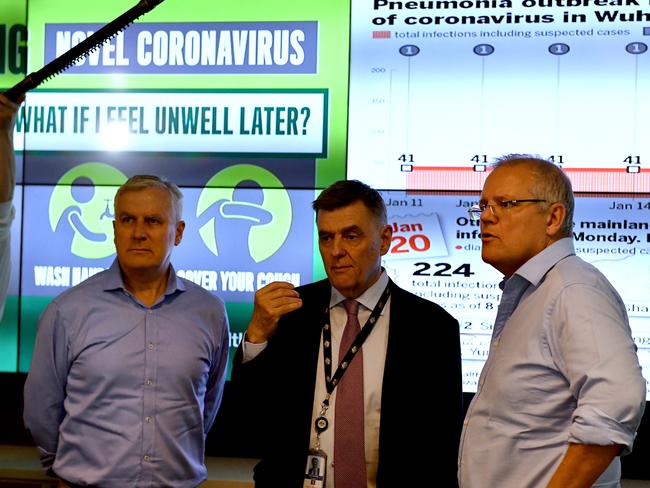
The traveller, in his 40s, had recently travelled to China, sparking concern with biosecurity officers. Test results later cleared him.
The virus, from the Chinese city of Wuhan, was detected at the end of last year and has spread to the US, Thailand, South Korea, Japan and Taiwan.
China’s National Health Commission said the virus was adapting and mutating, making it harder for authorities to control the outbreak.
The World Health Organisation was due to hold an emergency meeting last night to decide whether the outbreak constituted a global health emergency.
Prime Minister Scott Morrison met with Professor Murphy for a briefing about the threat at the Department of Health’s National Incident Room.
He was shown the new campaign to be rolled out at airports today, urging people travelling from Wuhan to wash their hands and cover their mouths when coughing.
Mr Morrison said he understood people were “somewhat anxious about this outbreak” but said Australian health agencies were “leaning forward”.
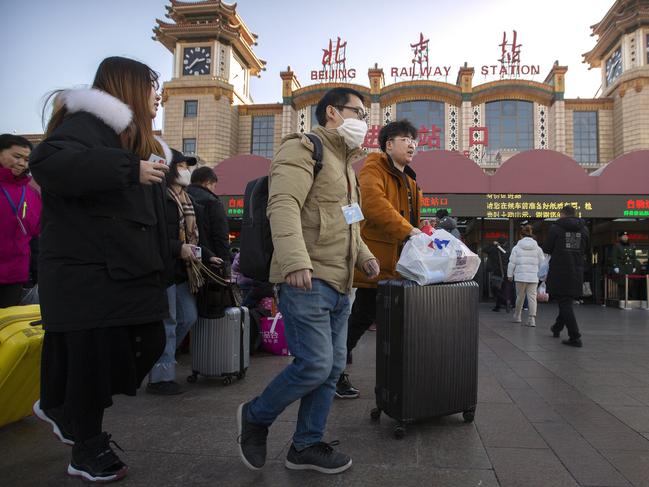
“The states and Commonwealth are working together to stay ahead of this,” he said.
A Brisbane man suspected of contracting a SARS-like disease while visiting China was cleared on Wednesday.
He was held in isolation at his Brisbane home until authorities confirmed he was not infected. A Queensland Health spokesman said tests showed the man had not been infected with the new virus.
WHAT YOU NEED TO KNOW ABOUT CORONAVIRUS
WORLD BAFFLED AT VIRUS
The world remains baffled by the newly-discovered coronavirus, which has infected hundreds of people and taken 17 lives, state television quoted the provincial government as saying.
The virus, known as 2019-nCov, originated in China and has not before been seen in humans. While symptoms can be as mild as a common cold, in severe cases it can cause pneumonia which can have deadly consequences
The outbreak is believed to have originated in the city of Wuhan in central China. The Chinese government’s confirmation that the new virus can be transmitted between people heightened fears it could spread faster and more widely just as millions of Chinese planned to travel for the Lunar New Year holiday.
China’s National Health Commission recently announced the death toll had risen from six to nine, and that 440 people in 13 Chinese provinces were infected.
Coronavirus has not yet been detected in Australia despite a number of people having been tested.
As health authorities race to develop a vaccine, here’s everything you need to know, and how you can protect yourself from infection:
WHAT IS CORONAVIRUS?
Coronavirus are a family of viruses that cause illnesses from the common cold to severe illnesses, typically they infect animals but a few affect humans like Middle East Respiratory Syndrome (MER-CoV) and Severe Acute Respiratory Syndrome (SARS).
The coronavirus currently causing concern is known as 2019-nCoV. It is a new strain that has not previously been identified in humans.
HOW MANY PEOPLE HAVE BEEN INFECTED?
So far around 440 people are known to have been infected. Most infections (270) have been in China, Thailand has reported two cases, Japan one, South Korea one-two cases and the US one case. Health authorities also investigated a suspected case in Queensland in a man who arrived from China, but he was cleared.
WHY IS THE VIRUS CONCERNING HEALTH AUTHORITIES?
Some coronaviruses can have severe death tolls. The MER-coV virus has a fatality rate of 26 per cent, SARS had a fatality rate of 12 per cent. This compares to the fatality rate for the influenza virus of less than one per cent. To date the new 2019 nCoV coronavirus has killed 6 people so it is so far not as severe as these more worrying coronaviruses.

WHAT ARE THE SYMPTOMS OF THE VIRUS?
The symptoms could be as mild as a common cold but in severe cases it the virus can cause severe pneumonia, fever and shortness of breath. People who develop severe pneumonia from the virus could go into septic shock (life threatening low blood pressure), respiratory failure or cardiac failure that could kill them
WHERE DID IT COME FROM?
The virus originated in the city of Wuhan in China the first cases were identified in people who travelled to local food markets and one theory is it was transmitted from animals to some of the humans who visited the market.
IS HUMAN TO HUMAN TRANSMISSION POSSIBLE?
Chinese health authorities have confirmed the virus is now being transmitted from human to human. A number of health workers in China contracted the virus from sick patients.
HOW CAN YOU CATCH IT?
The virus could be transmitted in droplets in the breath of infected people or could be transmitted if they leave traces of the virus on door handles or railings they have touched that are subsequently touched by others.
HOW CAN YOU PROTECT YOURSELF?
Wearing a face mask could help if the virus is transmitted through the air. Washing hands with soapy water regularly can help prevent the spread.
WHAT SHOULD YOU DO IF YOU HAVE A COLD LIKE VIRUS?
If you have been in contact with anyone who has recently travelled to China or an infected country who has been ill you should go to your doctor and get tested.
IS THERE A TEST FOR THE VIRUS?
The US has developed a fast test for the virus and is in the process of sharing it with other countries. Results can be returned within a day.
WHAT IS THE INCUBATION PERIOD?
It could take between seven to ten days after you are infected before symptoms of the virus emerge.
IS THERE A VACCINE?
Currently there is no vaccine but the National Institute of Health in the US is working on one. It could take months before it can be trialled.
Australia’s Chief Medical Officer Brendan Murphy said the University of Queensland has government funding for epidemic preparedness and may be asked to help develop a vaccine.
Originally published as Coronavirus: Aussies tested as researchers race to develop vaccine as China virus spreads
